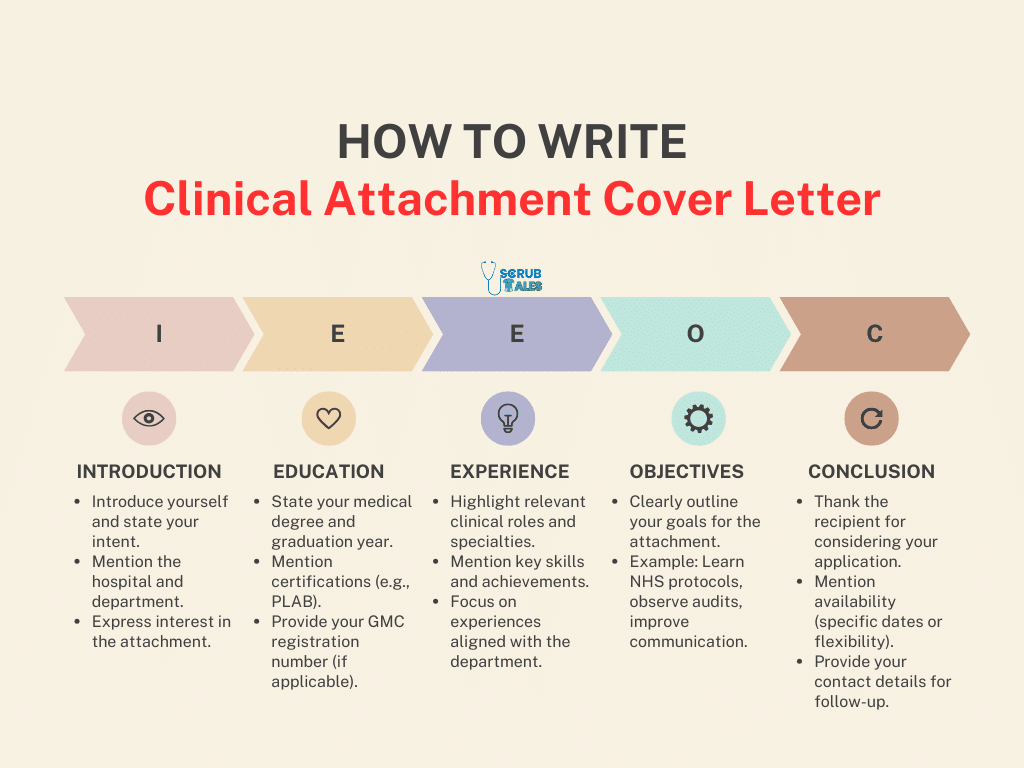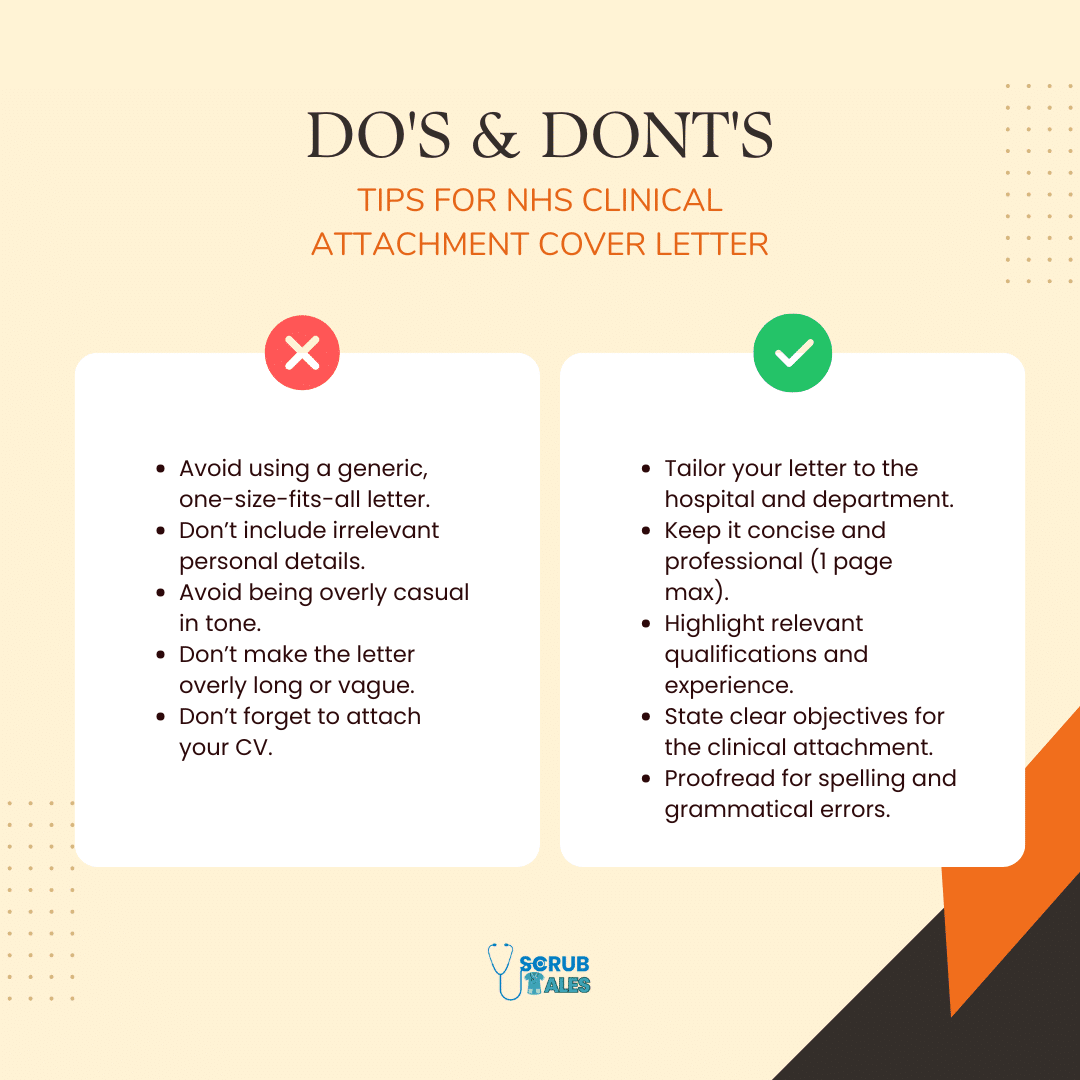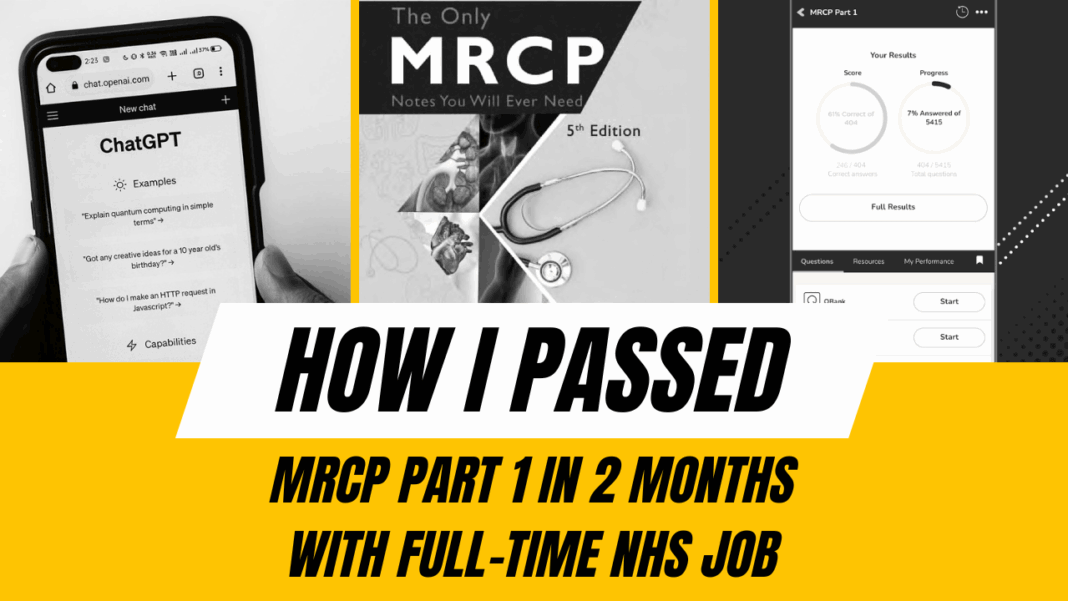Landing a job in the NHS has become increasingly competitive, especially for international medical graduates (IMGs). With a high number of applicants vying for limited positions, gaining relevant UK clinical experience through a clinical attachment in the NHS can set you apart.
With this blog post, I will provide you a Clinical Attachment Cover Letter template for NHS in a pdf form for free. Simultaneoulsy, I will guide you how you should write the cover letter to boost your chances of getting it.
Although doing one does not guarantee an NHS job, the application significantly boosts your chances by showcasing your commitment to learning how the NHS operates. To further improve your profile, consider enrolling in some of these free CPD courses tailored for Trac jobs, which can strengthen your application for clinical roles.
Download Your Free NHS Clinical Attachment Cover Letter Template
To make your application process smoother, we’ve created a ready-to-use Clinical Observership Cover Letter NHS template. This template is designed to help you highlight your qualifications, experience, and goals in a professional and compelling way.
You can download the template in both PDF and Word formats, making it easy to customize according to your needs.
PDF File
Please click the tiny download button on the top right to get the file.
Word File
How to Use the Template:
- Download the file in your preferred format (PDF or Word).
- Open the document and replace the placeholder text with your details.
- Tailor the content to match your specific NHS clinical attachment application and the hospital you’re applying to.
- Save your final version and attach it to your application email or copy paste in the mail itself and attach a CV with the email.
Why Use Our Template?
Finding effective cover letter examples for NHS clinical attachment applications is a difficult task, especially when you do not understand how consultants in the NHS are different than your home country (simple tip- either Respected Dr X or Dear Dr X is fine).
- Saves Time: Focus on writing rather than formatting.
- Professionally Written: Includes all the essential elements of a strong cover letter.
- Customizable: Edit the Word version to personalize your application.
Why a Clinical Attachment in the NHS Matters
Although previously, many IMGs used to land job in the same department where they would do the clinical attachment, this is not the case anymore. Very few people are able to get the NHS job in the same hospital, lucky are those who impress their consultants enough and make their dream of amazing salaried job.
Here are some points as to why it is still important to do one even if you are not sure of being successful in the getting the job itself.
- Hands-On Experience
- Gain insight into NHS processes like patient referrals, investigations, and multidisciplinary teamwork. Understanding the roles of different NHS staff in an MDT can prepare you to contribute effectively as you transition into the NHS.
- Boost Your Job Prospects
- A strong Clinical observership cover letter UK highlights your commitment to integrating into the UK healthcare system.
- Improve Communication Skills
- Learn to adapt your consultation style to meet NHS expectations, including patient-centered care and collaboration.
- Build Professional Relationships
- Network with consultants and staff, which can lead to future job opportunities or strong references.
- Enhance Your CV
- It shows employers that you’re proactive in understanding the system, giving you a competitive edge.
How to Write a Successful Clinical Attachment Cover Letter for the NHS
Using a template for your clinical attachment cover letter NHS is a great starting point, but personalizing it to reflect your unique experiences and aspirations is essential. Here’s how you can make the most out of the provided template:

1. Tailor the Introduction
When tailoring your cover letter, remember that this is the first step toward transitioning into an NHS role. You can explore our comprehensive Trac Jobs NHS application guide for tips on crafting strong applications and preparing for NHS interview questions later in your journey.
Replace the placeholders with your personal details:
- Your Full Name: Ensure your name matches the one on your CV and application forms.
- Hospital Name and Department: Research the specific hospital and department to mention them correctly.
- Why This Attachment?: Briefly state your motivation for applying to this particular hospital or department.
Example:
I am Dr. [Your Name], and I am writing to express my interest in a clinical attachment in the General Surgery Department at [Hospital Name].
2. Highlight Your Qualifications
Include your educational background and clinical experience:
- Your Medical School and Year of Graduation: E.g., “I graduated from X Medical College, India, in 2017.”
- Relevant Exams: Mention PLAB or any equivalent certifications.
- Clinical Experience: List roles and specialties you’ve worked in, focusing on skills relevant to the NHS.
3. Personalize Your Objectives
Adapt the list of goals to align with your career ambitions and the focus of the hospital. For instance:
- If applying to a teaching hospital, emphasize learning opportunities and QIPs.
- For a surgical department, focus on observing procedures and surgical team dynamics.
Example:
During this clinical attachment, I aim to:
- Understand NHS protocols for managing surgical cases.
- Observe multidisciplinary team collaboration in perioperative care.
4. Explain Your Connection to the Hospital
Show that you’ve researched the hospital and explain why you’re applying there.
- Reputation: Highlight a unique feature or achievement of the hospital.
- Personal Connection: Mention if you live nearby or have a family member working there.
Example:
I am particularly drawn to [Hospital Name] because of its excellence in patient-centered care and innovative research in minimally invasive surgery.
5. Close with Gratitude and Availability
End on a professional note:
- Thank the recipient for their time.
- Mention your availability for the attachment (specific dates).
- Add your contact details to encourage follow-up.
Example:
Thank you for considering my application. I am available for a 4–6 week attachment from [start date].
Tips for Effective Customization
- Be Specific: Avoid generic statements; show genuine interest in the role.
- Keep it Professional: Maintain a formal tone and check for grammatical errors.
- Limit to One Page: Ensure the cover letter is concise and to the point.
Once you are in the attachment, do not forget to simultaneously apply for jobs and make the best use of your time whenever you are free. I used to apply for least 4-5 jobs everyday when I was in an MDT. Make sure you know which places to apply for other than Trac jobs.
Step-by-Step Guide to Writing a Cover Letter for NHS Clinical Attachment
Writing a compelling clinical attachment cover letter NHS requires a structured approach. Follow this step-by-step guide to craft a professional and impactful letter and go through the best practices for drafting a cover letter for NHS clinical observership:
Start with a Polite Introduction
Begin your letter by introducing yourself and stating your intent to apply for a clinical attachment. Be concise and professional while setting the tone for the rest of the letter.
Example:
My name is Dr. [Your Name], and I am writing to express my interest in a clinical attachment in the [Department Name] at [Hospital Name]. As an international medical graduate, I am eager to gain firsthand exposure to NHS practices and enhance my understanding of patient care in the UK.
Mention Your Educational Background
Provide a brief overview of your academic qualifications and relevant certifications. Include details about your medical degree, year of graduation, and any exams like PLAB that you have completed.
Example:
I graduated with an MBBS degree from [Medical School Name] in [Year], followed by successful completion of the PLAB 1 and 2 exams. My GMC registration number is [Your GMC Number, if applicable].
Highlight Your Clinical Experience
List the most relevant roles and specialties you’ve worked in. Focus on experiences that align with the department or hospital you’re applying to.
Example:
I have [X years] of clinical experience in [Specialty/General Medicine], including roles at [Hospital Name, Location], where I gained extensive exposure to [specific tasks, e.g., surgical procedures, managing acute cases, etc.].
State Your Objectives for the Attachment
Clearly outline what you hope to achieve during the clinical attachment. Tailor these objectives to the hospital and department you’re applying to.
Example Objectives:
- Gain practical knowledge of NHS protocols for patient referrals, investigations, and discharges.
- Enhance my communication and leadership skills in a multidisciplinary team setting.
- Develop an understanding of audits, research, and Quality Improvement Projects (QIPs).
Explain Why You Chose This Hospital
Show that you’ve researched the hospital and explain why it aligns with your career goals. Mention any specific features or programs that attract you to the institution.
Example:
I am particularly drawn to [Hospital Name] due to its reputation for [specific achievement, e.g., excellence in patient care, innovative practices in surgery, etc.]. I believe this attachment will provide invaluable insights to support my transition into the NHS.
Close with Gratitude and a Call to Action
End your letter by thanking the recipient for their time and expressing your willingness to provide additional information. Mention your availability for the attachment and include your contact details.
Example:
Thank you for considering my application. I am available for a 4–6 week attachment from [start date] and would be happy to provide further details or references. Please feel free to contact me at [Your Phone Number] or [Your Email Address].
Quick Tips for Success
- Be concise and limit your letter to one page.
- Use a professional tone and avoid casual language.
- Proofread thoroughly to ensure there are no grammatical errors.
- Personalize each letter to the hospital and department you’re applying to.
Tips for NHS Clinical Attachment Cover Letter
Crafting a strong clinical attachment cover letter NHS is essential for making a positive impression. However, certain mistakes can reduce your chances of success. Here are some common pitfalls and how to avoid them.
Do read the guidelines for international doctors applying for clinical attachments in the NHS directly from GMC.

Using a Generic Cover Letter
One of the biggest mistakes applicants make is sending the same cover letter to multiple hospitals without tailoring it. A generic letter shows a lack of effort and interest in the specific hospital or department.
How to Avoid:
- Research the hospital and department.
- Mention specific aspects of the hospital, such as its achievements or reputation, to personalize your letter.
Overloading the Letter with Unnecessary Details
Including too much information about your entire career can make the letter lengthy and hard to read. Hiring managers often skim cover letters, so brevity is key.
How to Avoid:
- Focus only on your most relevant qualifications and experiences.
- Keep the letter concise and limit it to one page.
Failing to Clearly State Objectives
Not explaining what you hope to gain from the NHS clinical observership application can make your application appear directionless.
How to Avoid:
- Include specific goals, such as gaining insight into NHS protocols or improving communication skills in a multidisciplinary team.
- Tailor your objectives to align with the department’s focus.
Neglecting Grammar and Spelling
Errors in grammar or spelling can give the impression of carelessness and unprofessionalism.
How to Avoid:
- Proofread your letter multiple times.
- Use tools like Grammarly or ask a colleague to review it for you.
Ignoring Formatting and Structure
A poorly formatted letter can look unprofessional and make it difficult for the reader to follow.
How to Avoid:
- Use a clear structure with headings, paragraphs, and bullet points where appropriate.
- Ensure the font and alignment are consistent throughout.
Failing to Mention Availability
If you don’t specify when you’re available for the attachment, it may delay your application process.
How to Avoid:
- Clearly state the dates you’re available for the attachment.
- Include flexibility if applicable (e.g., “I am available for 4–6 weeks starting from [date]”).
Forgetting to Attach Your CV
Your cover letter should be accompanied by your CV, providing additional details about your qualifications and experience.
How to Avoid:
- Double-check that your CV is attached before sending the email or application.
- Ensure your CV and cover letter have consistent formatting.
Sample Cover Letter for Clinical Attachment
Below is a sample clinical attachment cover letter NHS to help you understand how to apply the guidelines and tips effectively. Use this as inspiration when crafting your own letter, ensuring you customize it to reflect your unique background and goals.
Dr. Jane Doe
123 High Street
London, UK
[email protected] | +44 7123 456 789
[Date]
Dr. John Smith
General Surgery Department
Royal London Hospital
London, UK
Subject: Application for Clinical Attachment in General Surgery
Dear Dr. Smith,
I am writing to express my interest in a clinical attachment in the General Surgery Department at Royal London Hospital. As an international medical graduate with a strong background in surgery, I am eager to gain firsthand experience in NHS practices and enhance my understanding of surgical care in the UK.
I graduated with an MBBS degree from University of Medical Sciences, India, in 2017. During my three years of clinical practice, I worked as a Junior Resident in General Surgery at City Hospital, where I gained extensive experience in pre-operative and post-operative care, assisting in major surgeries, and managing acute surgical emergencies. My GMC registration number is 1234567, and I have successfully completed the PLAB 1 and 2 exams.
Through this clinical attachment, I aim to:
- Understand NHS protocols for managing surgical cases, including patient referrals and discharge planning.
- Enhance my communication and teamwork skills by working in a multidisciplinary team.
- Observe Quality Improvement Projects (QIPs) and audits in surgical care.
I am particularly drawn to Royal London Hospital due to its reputation for excellence in minimally invasive surgery and patient-centered care. I believe that observing and learning under the guidance of your esteemed team will provide invaluable insights for my transition into the NHS.
I have attached my CV for your review and would be happy to provide additional details or references upon request. I am available for a 4–6 week attachment starting from [preferred start date].
Thank you for considering my application. I look forward to the opportunity to contribute to and learn from your team.
Yours sincerely,
Dr. Jane Doe
- GMC Number: 1234567
- Phone: +44 7123 456 789
- Email: [email protected]
FAQs
How do I write a cover letter for a clinical attachment?
To write a clinical attachment cover letter, introduce yourself, highlight your qualifications and experience, and clearly state your objectives for the attachment. Personalize the letter to the hospital and department you’re applying to, and keep it concise and professional.
Does a clinical attachment count as NHS experience?
A clinical attachment does not count as formal NHS work experience since it is observational. However, it demonstrates your understanding of NHS practices and protocols, which can strengthen your job application.
Many Trac Job applications now clearly state not to mention clinical attachment or observership in the application.
How do I write a cover letter for the NHS?
Start with a polite introduction, mention your qualifications and relevant clinical experience, explain your motivation for applying, and tailor the letter to the specific NHS role or department. End with gratitude and a call to action.
How do I write an expression of interest letter in the NHS?
An expression of interest letter should be concise and state why you’re interested in the role, your relevant skills and experience, and how you can contribute to the NHS team. Keep the tone professional and positive.
How do I write a good NHS supporting statement?
In an NHS supporting statement, address the job description and person specification directly. Provide specific examples of your skills, experience, and achievements that align with the role’s requirements. Use clear and structured paragraphs.
If you are looking for complete guide and sample templates, check out our post on Trac Jobs Application Guide.
What should I say instead of “I am writing” to express my interest?
You can use phrases like:
“I wish to express my interest in…”
“I am excited to apply for…”
“I am reaching out regarding the opportunity to…”
How do I start a cover letter?
Begin your cover letter with a polite introduction that includes your name, the purpose of the letter, and a brief mention of the role or opportunity you are applying for. For example:
“My name is Dr. [Your Name], and I am writing to express my interest in a clinical attachment in the [Department Name] at [Hospital Name].”
How do I prepare for a clinical attachment in the NHS?
Along with writing a strong cover letter, familiarize yourself with resources like these medical apps for NHS doctors, which can streamline your workflow during your attachment.


